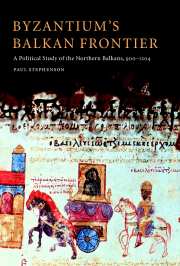Book contents
- Frontmatter
- Contents
- List of maps and figures
- Preface
- A note on citation and transliteration
- List of abbreviations
- Introduction
- 1 Bulgaria and beyond: the Northern Balkans (c.900–963)
- 2 The Byzantine occupation of Bulgaria (963–1025)
- 3 Northern nomads (1025–1100)
- 4 Southern Slavs (1025–1100)
- 5 The rise of the west, I: Normans and Crusaders (1081–1118)
- 6 The rise of the west, II: Hungarians and Venetians (1100–1143)
- 7 Manuel I Comnenus confronts the West (1143–1156)
- 8 Advancing the frontier: the annexation of Sirmium and Dalmatia (1156–1180)
- 9 Casting off the ‘Byzantine Yoke’ (1180–1204)
- Conclusions
- Bibliography
- Index
4 - Southern Slavs (1025–1100)
Published online by Cambridge University Press: 25 August 2009
- Frontmatter
- Contents
- List of maps and figures
- Preface
- A note on citation and transliteration
- List of abbreviations
- Introduction
- 1 Bulgaria and beyond: the Northern Balkans (c.900–963)
- 2 The Byzantine occupation of Bulgaria (963–1025)
- 3 Northern nomads (1025–1100)
- 4 Southern Slavs (1025–1100)
- 5 The rise of the west, I: Normans and Crusaders (1081–1118)
- 6 The rise of the west, II: Hungarians and Venetians (1100–1143)
- 7 Manuel I Comnenus confronts the West (1143–1156)
- 8 Advancing the frontier: the annexation of Sirmium and Dalmatia (1156–1180)
- 9 Casting off the ‘Byzantine Yoke’ (1180–1204)
- Conclusions
- Bibliography
- Index
Summary
We have already encountered the southern Slavs, and referred to several of the distinct regions that they occupied. Unlike the Pechenegs, the Slavs had been settled within the Balkan lands for several centuries, and various groups had developed sedentary power structures in particular geographical contexts. Peoples, lands and their correct or appropriate names are matters of considerable importance in the history of the Balkans, and it is only sensible to consider some medieval perceptions. William of Tyre (97–8; trans.: i, 139–41) knew the whole region between the Danube and the Adriatic as Dalmatia, and both Anna Comnena (Alexiad: i, 60, 155; trans.: 72, 144) and John Cinnamus (12; trans.: 19) refer to the region's various inhabitants as Dalmatians. However, there was little unity in the region, and the fragmented nature of political authority is reflected in certain texts. The DAI (145) enumerates the various lands in the mid–tenth century: Duklja (also called Dalmatia Superior, and later Zeta), Zahumlje (Hum), Travunija (Trebinje), Dalmatia Inferior, and Croatia. Travelling further inland one reached the highland regions of Raška (also known as Rassa and Rascia), and Bosna (or Bosnia).
Each of the larger regions comprised many smaller districts or counties known as župas or županias, governed by župans. The DAI (144–51) also provides unique contemporary information on the northern lands, which were settled by the Croats.
- Type
- Chapter
- Information
- Byzantium's Balkan FrontierA Political Study of the Northern Balkans, 900–1204, pp. 117 - 155Publisher: Cambridge University PressPrint publication year: 2000



